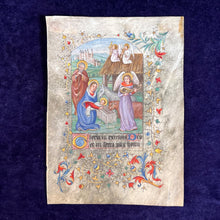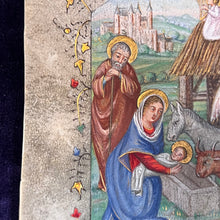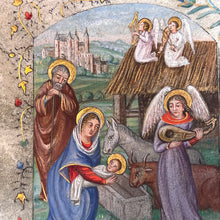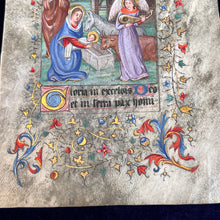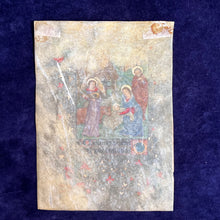
Likely 19th c., imitating medieval illumination. Single illustrated leaf on vellum. Blank on verso. Nativity scene, figures nimbed in gold. Two lines of text (terminating in a truncated word). Full border with acanthus leaves and ivy.
Forgery is a strong word. The Spanish Forger certainly took pains to present his additions to pre-existing medieval parchment as authentically created from the past. The artist behind this handmade reproduction may have been practicing the craft or may have created this piece to pass off as a genuine medieval illustration of the nativity, but the details tell the tale.
What the piece wants to be is a 15th century French or Flemish from a Book of Hours. And overall it makes for a lovely attempt, but the individual features don’t add up. The background castle, the faces of Mary, Joseph, and the Angels, and the folds in the garments present a Northern Renaissance style sophistication; however the border, which at this stage should be a dense and intricate pattern, or a strewn border, seems haphazardly put together, not quite filling the space. The acanthus and ivy do not interact in the organic way that 15th century manuscripts establish. The foliage at the top right seems to have started as an acanthus leaf, but morphed into something like a sprig of rosemary. The colours are not quite right— the red too bright without the warmth of cinnabar; the blue appears closer to a 19th c.-invention of Cobalt blue than the blue created from lapis lazuli, folium, or indigo.
The ruling for the illustration has a mistake— the image sits in a black ruled section and the black ruled section enclosing the text has a line that extends parallel to the image ruling, rather than joining with it.
The illuminated G opening “Gloria in excelsis” does not conform to the conventions of Gothic palaeography of any era, featuring a strangely swirled and pointed bar. The text is truncated at “Deo et in terra pax homi-” but does not continue on the verso. The verso is, in fact, blank. One explanation for this could be that the image is the verso and would continue onto a (now lost) recto. That is to say that the rest of the word could follow on the next page rather than the back of this page. In a medieval manuscript, this would indicate that this was an on-spec illumination designed to be tipped into an unilluminated or unpersonalised Book of Hours. However, this is unlikely as these bespoke pages would not leave a truncated word to be joined up with the set text, and likewise a set text would not have the end of a truncated word left hanging. This word more likely suggests that the image was (loosely) copied from an extant leaf and the artist rendered the text as it was on the original page.
Finally, the parchment is absolutely wrong for a medieval book. The leaf appears oily, suggesting that it is sheep, which would not be uncommon for a manuscript produced on the British Isles, but would be unusual for a continental manuscript. Further, the parchment is nearly translucent and stiff, quite unlike even the still-opaque and delicate leaves that support even the Paris Pocket bibles. The suppleness of the leaf is somewhat similar to a piece of laminated paper. The transparency is evident from the visibility of the illustration on the verso, and is highlighted in hand as you can easily see your fingers through it.
MB367





